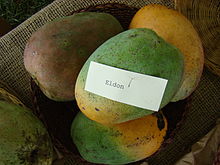| Mangifera 'Eldon' | |
|---|---|
 Eldon mangoes at the Redland Summer Fruit Festival,
Fruit and Spice Park,
Homestead, Florida | |
| Genus | Mangifera |
| Species | Mangifera indica |
| Hybrid parentage | ' Cowasji Patel' × unknown |
| Cultivar | 'Eldon' |
| Breeder | Walter B. Eldon |
| Origin | Florida, USA |
The 'Eldon' mango is a mango cultivar which originated in south Florida, USA. Eldon eventually became a commercially adopted variety.
History
The original tree was grown from a seed on the property of Walter B. Eldon in Miami, Florida in 1939. [1] Reportedly the seed had been a Haden seed, and a 1995 analysis supported this; however a 2005 pedigree study did not support this, estimating that Eldon was likely a seedling of Cowasji Patel instead. [2] The original tree first fruited in 1942. Propagation was begun around 1948 by Lawrence Zill and J.W. Chafer.
While Eldon did not become a popular nursery stock tree in Florida over the following decades, it did eventually gain commercial acceptance in Africa. [3]
Eldon trees are planted in the collections of the USDA's germplasm repository in Miami, [4] and the University of Florida's Tropical Research and Education Center in Homestead, Florida. [5]
Eldon may have been a parent of the Southern Blush mango.
Description
The fruit is of oval shape and averages about a pound in weight; moreover, the fruit may have variegated color upon maturity, and can be a mix of green, yellow, orange and red blush. The flesh is yellow and has a sweet flavor with a pleasant aroma. The fruit contains a monoembryonic seed.
The trees are moderately vigorous with a large canopy that contains light green leaves.
References
- ^ Ledin, R. Bruce (1954). "Mango Varieties" (PDF). Proceedings of the Florida State Horticultural Society. 67: 284–290. Archived from the original (PDF) on 2011-07-26.
- ^ Olano, Cecile T.; Schnell, Raymond J.; Quintanilla, Wilber E.; Campbell, Richard J. (2005). "Pedigree analysis of Florida mango cultivars" (PDF). Proceedings of the Florida State Horticultural Society. 118: 192–197. Archived from the original (PDF) on 2010-06-18.
-
^
"Archived copy" (PDF). Archived from
the original (PDF) on 2011-07-06. Retrieved 2010-04-04.
{{ cite web}}: CS1 maint: archived copy as title ( link) - ^ http://www.ars-grin.gov/cgi-bin/npgs/acc/display.pl?1083571 Archived 2009-05-08 at the Wayback Machine USDA, ARS, National Genetic Resources Program. Germplasm Resources Information Network - (GRIN). [Online Database] National Germplasm Resources Laboratory, Beltsville, MD
- ^ http://trec.ifas.ufl.edu/crane/pdfs/TREC-Fruit-Collections.pdf Archived 2018-04-08 at the Wayback Machine p., #27
| Mangifera 'Eldon' | |
|---|---|
 Eldon mangoes at the Redland Summer Fruit Festival,
Fruit and Spice Park,
Homestead, Florida | |
| Genus | Mangifera |
| Species | Mangifera indica |
| Hybrid parentage | ' Cowasji Patel' × unknown |
| Cultivar | 'Eldon' |
| Breeder | Walter B. Eldon |
| Origin | Florida, USA |
The 'Eldon' mango is a mango cultivar which originated in south Florida, USA. Eldon eventually became a commercially adopted variety.
History
The original tree was grown from a seed on the property of Walter B. Eldon in Miami, Florida in 1939. [1] Reportedly the seed had been a Haden seed, and a 1995 analysis supported this; however a 2005 pedigree study did not support this, estimating that Eldon was likely a seedling of Cowasji Patel instead. [2] The original tree first fruited in 1942. Propagation was begun around 1948 by Lawrence Zill and J.W. Chafer.
While Eldon did not become a popular nursery stock tree in Florida over the following decades, it did eventually gain commercial acceptance in Africa. [3]
Eldon trees are planted in the collections of the USDA's germplasm repository in Miami, [4] and the University of Florida's Tropical Research and Education Center in Homestead, Florida. [5]
Eldon may have been a parent of the Southern Blush mango.
Description
The fruit is of oval shape and averages about a pound in weight; moreover, the fruit may have variegated color upon maturity, and can be a mix of green, yellow, orange and red blush. The flesh is yellow and has a sweet flavor with a pleasant aroma. The fruit contains a monoembryonic seed.
The trees are moderately vigorous with a large canopy that contains light green leaves.
References
- ^ Ledin, R. Bruce (1954). "Mango Varieties" (PDF). Proceedings of the Florida State Horticultural Society. 67: 284–290. Archived from the original (PDF) on 2011-07-26.
- ^ Olano, Cecile T.; Schnell, Raymond J.; Quintanilla, Wilber E.; Campbell, Richard J. (2005). "Pedigree analysis of Florida mango cultivars" (PDF). Proceedings of the Florida State Horticultural Society. 118: 192–197. Archived from the original (PDF) on 2010-06-18.
-
^
"Archived copy" (PDF). Archived from
the original (PDF) on 2011-07-06. Retrieved 2010-04-04.
{{ cite web}}: CS1 maint: archived copy as title ( link) - ^ http://www.ars-grin.gov/cgi-bin/npgs/acc/display.pl?1083571 Archived 2009-05-08 at the Wayback Machine USDA, ARS, National Genetic Resources Program. Germplasm Resources Information Network - (GRIN). [Online Database] National Germplasm Resources Laboratory, Beltsville, MD
- ^ http://trec.ifas.ufl.edu/crane/pdfs/TREC-Fruit-Collections.pdf Archived 2018-04-08 at the Wayback Machine p., #27
